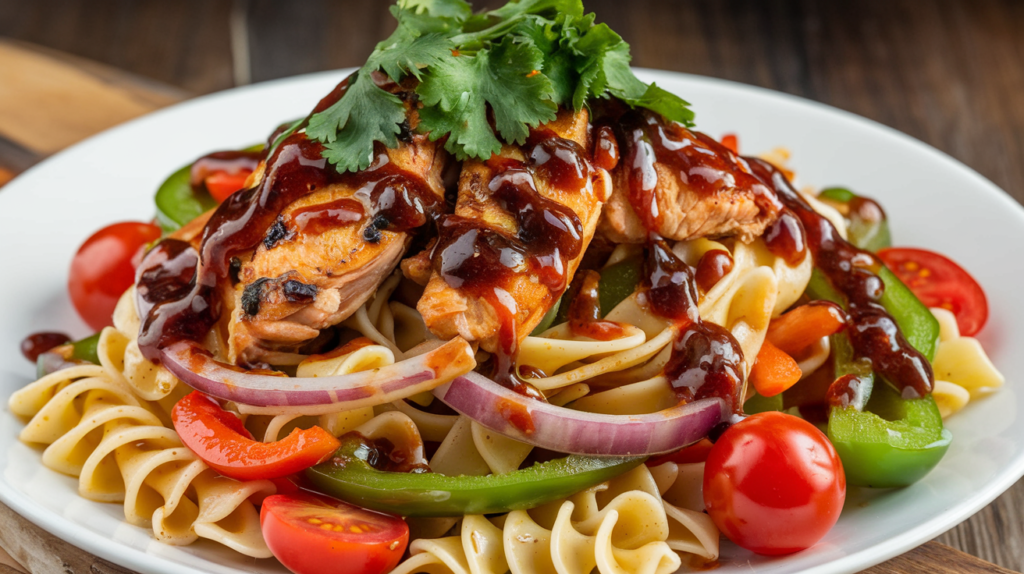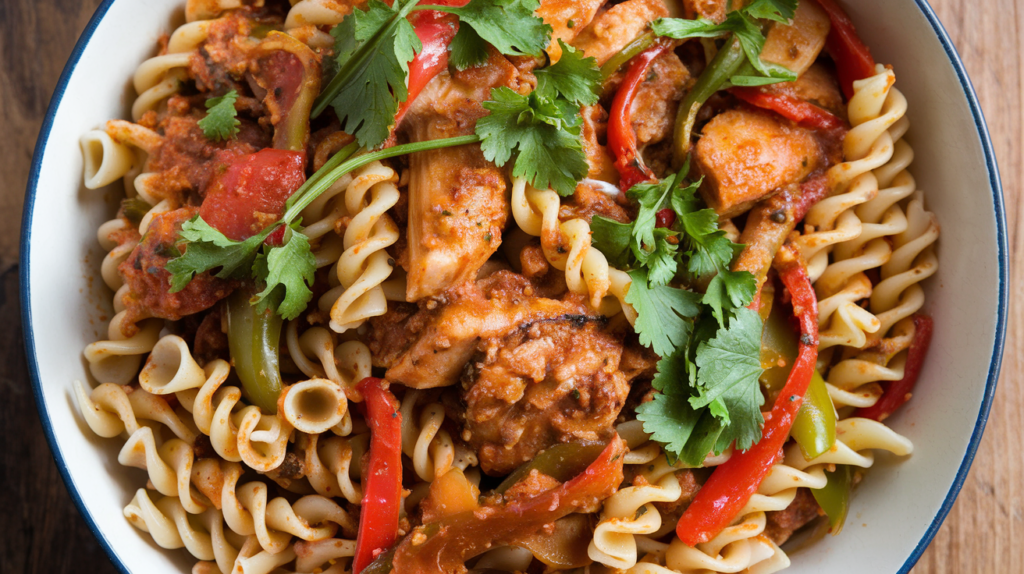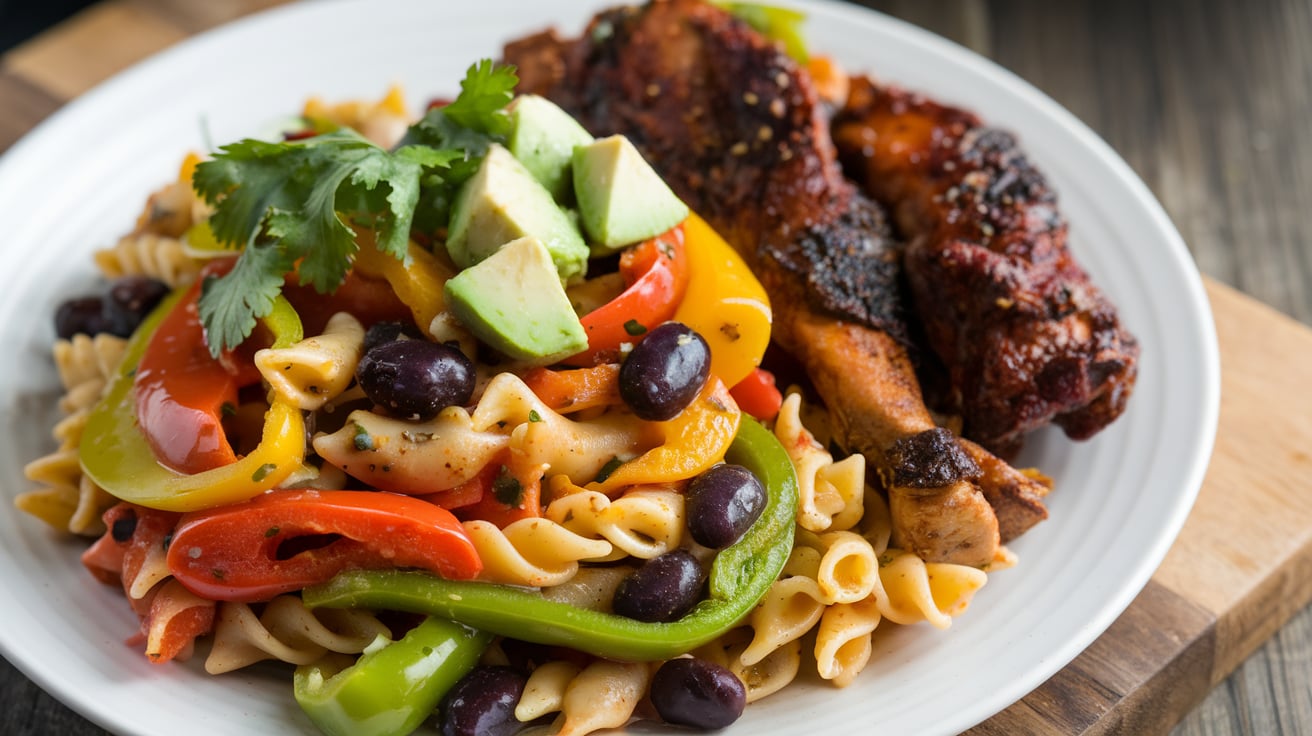Rasta Pasta Recipe: A Fusion of Caribbean and Italian Flavors
Introduction
Rasta Pasta is a colorful and flavorful dish that has gained popularity due to its unique combination of Caribbean spices and Italian pasta. It features jerk seasoning, bell peppers, and a creamy sauce, making it a hearty and satisfying meal. Whether you’re making a vegan version, or adding chicken or shrimp, this Rasta Pasta recipe will deliver bold flavors and rich textures, perfect for any occasion.
Table of Contents
What is Rasta Pasta?
Rasta Pasta is a Caribbean-inspired dish that blends the heat and spice of jerk seasoning with the comfort of creamy pasta. The dish usually includes colorful bell peppers, pasta (typically penne), and jerk-seasoned protein like chicken, shrimp, or tofu. The addition of a rich, creamy sauce balances out the spiciness, making it a crowd-pleasing meal that is both vibrant and filling.
Ingredients for Rasta Pasta
To create the perfect Rasta Pasta, you’ll need:
- 8 oz penne pasta (or your preferred pasta type)
- 1 pound of chicken breasts, shrimp, or tofu for a vegan version
- 3 tablespoons of jerk seasoning
- 1 tablespoon olive oil
- 1 medium red bell pepper, sliced
- 1 medium green bell pepper, sliced
- 1 medium yellow bell pepper, sliced
- 2 cloves garlic, minced
- 1 cup heavy cream (or coconut milk for a dairy-free option)
- ½ cup Parmesan cheese (or nutritional yeast for a vegan alternative)
- Fresh parsley, chopped, for garnish
- Salt and pepper to taste
How to Make Rasta Pasta
Step 1: Cooking the Pasta
Cook the penne pasta in salted boiling water until al dente, following the package instructions. Drain and set aside. It’s important to cook the pasta just right to ensure it absorbs the creamy jerk sauce later.
Step 2: Preparing the Protein for Rasta Pasta
Season your choice of protein—whether it’s chicken, shrimp, or tofu—with jerk seasoning. In a skillet, heat the olive oil over medium-high heat and cook the protein until it’s fully cooked (about 5-7 minutes for chicken or shrimp). For tofu, sauté until it’s golden and crispy. Set the protein aside once done.
Step 3: Sautéing the Vegetables
Using the same skillet, add the sliced red, green, and yellow bell peppers. Sauté for about 4-5 minutes, until they soften but still have some crunch. Add minced garlic and cook for an additional minute. The colorful bell peppers not only add vibrancy to the dish but also provide sweetness that balances the spice of the jerk seasoning.
Step 4: Making the Creamy Jerk Sauce for Rasta Pasta
Reduce the heat to medium and pour in the heavy cream or coconut milk for a dairy-free alternative. Stir in the Parmesan cheese (or nutritional yeast if making a vegan version) and allow the sauce to thicken. If it becomes too thick, add a little reserved pasta water to reach the perfect consistency. The creaminess of the sauce is key to balancing the spice of the jerk seasoning in Rasta Pasta.
Step 5: Mixing the Pasta with Sauce
Combine the cooked pasta, the sautéed vegetables, and the cooked protein in the skillet with the creamy jerk sauce. Stir everything together until the pasta is evenly coated and the jerk seasoning is well-distributed. Taste and adjust the seasoning with salt and pepper as needed.

Tips for Making the Best Rasta Pasta
- Use Al Dente Pasta
For the best Rasta Pasta, make sure the pasta is cooked al dente. This ensures that the pasta holds up well when mixed with the creamy jerk sauce. - Homemade Jerk Seasoning
If possible, make your own jerk seasoning to control the spice level and flavor. Jerk seasoning typically includes allspice, Scotch bonnet peppers, thyme, cinnamon, and more, giving Rasta-Pasta its distinctive Caribbean flair. - Spice Levels
Jerk seasoning can be very spicy, so adjust the quantity to your preference. If you’re unsure, start with a small amount and add more as you taste. - Vegan and Gluten-Free Options
To make vegan Rasta-Pasta, swap out the heavy cream for coconut milk and use tofu or tempeh instead of chicken or shrimp. For gluten-free Rasta-Pasta, use a gluten-free pasta alternative like rice or quinoa pasta.
Rasta Pasta Variations
Vegan Rasta Pasta
Replace the chicken or shrimp with tofu or tempeh, and use coconut milk instead of heavy cream. Nutritional yeast can be substituted for Parmesan cheese to keep the dish dairy-free while still maintaining a cheesy flavor.
Shrimp Rasta Pasta
Shrimp Rasta-Pasta is a seafood lover’s dream. The shrimp adds a light, briny flavor that pairs well with the spicy jerk seasoning and creamy sauce. Just be sure to not overcook the shrimp, as they only need about 4-5 minutes in the skillet.
Chicken Rasta Pasta
Chicken is a popular protein for Rasta-Pasta because it absorbs the jerk seasoning well, making each bite flavorful. Be sure to cook the chicken thoroughly, but don’t overcook it to avoid dryness.
Gluten-Free Rasta Pasta
For those with gluten sensitivities, simply swap out regular pasta for gluten-free pasta. The rest of the dish remains naturally gluten-free, so this adaptation is quick and easy.
The Importance of Jerk Seasoning in Rasta Pasta
Jerk seasoning is the soul of Rasta-Pasta. A traditional jerk seasoning includes a mix of allspice, thyme, Scotch bonnet peppers, and cinnamon. The blend creates a spicy, sweet, and savory profile that elevates the dish to new heights. Here’s a simple homemade jerk seasoning recipe for your Rasta-Pasta:
- 1 tablespoon ground allspice
- 1 tablespoon dried thyme
- 1 teaspoon ground cinnamon
- 1 teaspoon cayenne pepper
- 1 teaspoon ground ginger
- 1 teaspoon garlic powder
- 1 teaspoon onion powder
- 1 teaspoon smoked paprika
- ½ teaspoon ground nutmeg
- Salt and pepper to taste

Health Benefits of Rasta Pasta
Rasta Pasta is not only delicious but also nutritious when made with whole ingredients. Bell peppers are high in vitamins A and C, providing antioxidants and immune support. Using coconut milk adds healthy fats to the dish, while jerk seasoning includes spices like ginger and garlic that offer anti-inflammatory properties.
If you choose a plant-based version, tofu or tempeh adds protein, making it a well-rounded meal. Whole wheat or gluten-free pasta options also boost the fiber content, making Rasta Pasta a healthier, balanced option.
Conclusion: A Delicious Twist on Classic Pasta
Rasta Pasta is a delightful fusion of Caribbean and Italian cuisines, offering bold flavors and a hearty, satisfying meal. Whether you’re making it for a family dinner or serving it at a special gathering, this dish is sure to impress. With its vibrant colors, creamy sauce, and spicy kick, Rasta Pasta is perfect for anyone looking to explore new culinary horizons. Don’t forget to customize it with your choice of protein and spice levels to make it your own!
There are no reviews yet. Be the first one to write one.







